|
|
ARTHROPODS:
Insects»
Spiders»
Centipedes»
Millipedes»
Sowbugs»
Harvestmen»
Mites
& Ticks»
Scorpions»
Identification
Tips»
About
the Critter Files»
Links» |
|
|
|
 |
HOUSE
FLIES
Including
BLOW FLIES, FLESH FLIES, & TACHINID FLIES
Critter
Files/Insects/True
Flies/House Flies & Their Relatives
By Blake Newton
University of Kentucky Department of Entomology |
| |
|
| Common
Kentucky House Flies: |
| |
| TAXONOMY |
KINGDOM:
Animalia | PHYLUM: Arthropoda | CLASS: Insecta | ORDER :Diptera
FAMILIES: Muscidae (house flies), Calliphoridae (blow flies), Sarcophagidae
(flesh flies), Tachinidae (tachinid flies) |
| |
WHAT
IS A HOUSE FLY?
LIFE CYCLE
ECOLOGY
PEST STATUS
COMMON KENTUCKY HOUSE FLIES
COLLECTING & PHOTOGRAPHY
HOUSE FLY FACTS
MYTHS, LEGENDS, AND FOLKLORE |
| |
| WHAT
IS A HOUSE FLY? |
|
| Many fly species
in the related families Muscidae, Calliphoridae, Sarcophagidae, and
Tachinidae closely resemble one-another. Although only one species
(Musca domestica, in the family Muscidae) is properly called
the "house fly," many species from these four families are
nearly identical in appearance and are commonly found in houses. Some
of the flies called "house flies" are really blow
flies, flesh flies, or tachinid
flies. All of these flies are usually dark colored or metallic,
about 3/8" long, robust, and hairy. Although
it can be difficult to determine the family to which any one of
these flies belongs, there are common characteristics exhibited
by each family which are highlighted in the Common Types section
below. These characteristics can aid in identification, but
a microscope is essential for accurate identification. For
technical details on identifying these flies, consult an accurate
guide to insect taxonomy, such as:
Peterson
Field Guide to Insects:
Borror and White
Introduction
To The Study of Insects:
Borror, Triplehorn, and Johnson
Like all true flies (order
Diptera), house flies and their relatives do not have chewing mouthparts.
Instead, most flies in these 4 families have sponging mouthparts
which are used to absorb liquids, such as nectar. Others,
like stable flies, have piercing mouthparts used to suck blood.
Like all insects, flies have 6 legs, 3 body regions (head,
thorax, and abdomen) and 2 antennae.
Except for a few species
whose larvae are parasitic on other insects, larvae from the "house
fly" families are legless, soft-bodied maggots. Maggots
are most commonly found in carrion or in animal waste. |
| |
|
| SIZE:
Adult body length up to 5/8", larvae up to 4/8" |
| |
| LIFE
CYCLE |
|
Like
all flies, house flies and their relatives have complete metamorphosis
with egg, larval, pupal, and adult stages. The larvae are
legless and wormlike. Winged adults are active outdoors during
warm months, and indoors all year round. |
| |
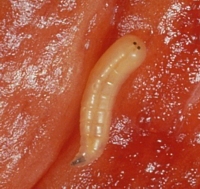 Blow fly larva:
a typical maggot (R. Bessin, 2000)
Blow fly larva:
a typical maggot (R. Bessin, 2000) |
| |
| ECOLOGY |
|
Most flies in the families
Muscidae (house flies and stable flies), Calliphoridae (blow flies),
and Sarcophagidae (flesh flies) breed in carrion, animal wounds, or
animal waste. Because of this, they can be found almost anywhere,
indoors or out. Maggots serve an important ecological role by
breaking down carrion, dung, and other wastes. They are also
a food source for birds and many kinds of predatory insects, including
carrion beetles and rove beetles. Although some adult flies
in these groups, such as stable flies, feed on blood, most adults
use their sponging mouthparts to feed on nectar and other liquids.
Flies are preyed upon by a variety of animals, including birds,
spiders, dragonflies, and other flying insects. Because they
sometimes visit flowers for nectar, house flies and their relatives
are important pollinators.
|
| |
| Parasitoid Flies:
Although most flies in these 4 families lay their eggs in organic
waste, some species (especially in the families Sarcophagidae and
Tachinidae) lay their eggs inside other insects, where the larvae
feed and develop. Some of these flies are important for reducing
the numbers of insect pests. |
| |
| PEST
STATUS |
|
Their are
many important pests in the families Muscidae, Calliphoridae, and
Sarcophagidae. Flies in all of these families are a nuisance
when they get into homes and when they occasionally spread diseases
to humans. Read about the control of home-invading flies in
our ENTFact:
www.uky.edu/Agriculture/Entomology/entfacts/struct/ef624.htm
The family Muscidae also
contains Face Flies, Horn Flies, and Stable Flies. These flies
harm livestock by causing irritation and spreading disease. Read
about these livestock pests in the following ENTFacts:
Face
Flies and Pink Eye
Horn
Flies and Cattle
Some flies in the families
Calliphoridae and Sarcophagidae are capable of infecting open wounds
on humans and animals, a condition known as myiasis. Myiasis
in humans is rare in the United States, but commonly occurs in tropical
regions. |
| |
| COMMON
KENTUCKY HOUSE FLIES, BLOW FLIES, FLESH FLIES, & TACHINID FLIES |
|
|
THE
HOUSE FLY
FAMILY: Muscidae
| GENUS and SPECIES: Musca domestica
The House Fly,
Musca domestica, pictured below, is one of the most common
members of the family Muscidae, and one of the most common flies
found in homes. It is about 1/4" long, and gray with
4 black stripes on the thorax. The house fly doesn't bite,
unlike face flies, stable flies, and horn flies, which are also
in the family Muscidae. Muscid flies and their maggots breed
most commonly in manure. |
| |
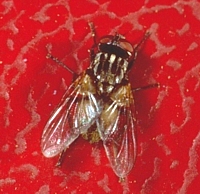 The House Fly,
Musca domestica (R. Bessin, 2000)
The House Fly,
Musca domestica (R. Bessin, 2000) |
|
|
|
BLOW
FLIES
FAMILY:
Calliphoridae
Flies
in the family Calliphoridae are called "Blow Flies."
Many blow
flies have distinctive metallic blue or green coloration.
Blow flies and their maggots are most commonly associated with
decaying animal flesh. |
| |
 Blow Fly (R. Bessin, 2000)
Blow Fly (R. Bessin, 2000) |
 Blow Fly
(R. Bessin, 2000)
Blow Fly
(R. Bessin, 2000) |
|
|
|
FLESH
FLIES
FAMILY:
Sarcophagidae
Flies
in the family Sarcophagidae are the "Flesh Flies,"
so-called because many species lay their eggs in open wounds. Flesh
flies are very common and are difficult to distinguish from the "house
fly" in the family Muscidae. A rule of thumb: flesh flies
usually have 3 black lines on their thorax; true house flies have
4. Although they are called flesh flies, not all of the flies in this
family develop in wounds. Many are associated with carrion,
and some are parasites of beetles and other insects. |
| |
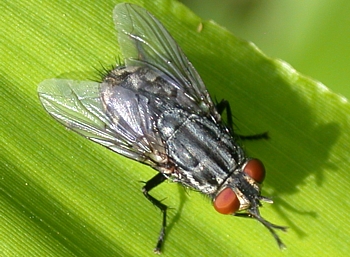 Flesh Fly (B.
Newton 2006)
Flesh Fly (B.
Newton 2006) |
|
|
|
TACHINID
FLIES
FAMILY:
Tachinidae
Flies
in the family Tachinidae, commonly called "Tachinid Flies,"
are parasites of other insects. Like parasitic wasps, tachinid
larvae live in or on other insects, and some tachinid flies help reduce
pest numbers. Tachinid flies come in many shapes, sizes, and
colors, but many feature gray stripes and dark-colored bodies, making
them very difficult to distinguish from true house flies and flesh
flies. Although an insect taxonomy guide and a microscope are
needed to accurately identify these flies, tachinid flies are often
very robust and hairy when compared to flesh flies and true house
flies. Pictured below are 2 common tachinid flies. |
| |
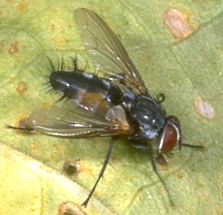 Tachinid Fly
(R. Bessin, 2000)
Tachinid Fly
(R. Bessin, 2000) |
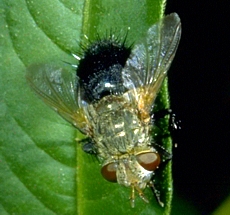 Tachinid Fly
(R. Bessin, 2000)
Tachinid Fly
(R. Bessin, 2000) |
|
| |
| COLLECTING
& PHOTOGRAPHY |
|
House flies and their
relatives are easy to find in Kentucky. House flies, flesh
flies, and blow flies are found year round, and are especially common
in barns or other areas where animal waste is present. Tachinid
flies are common as well, but are more likely to be found in weedy
areas and in agricultural crops. None of these flies are very
common during winter months. All of these flies are good fliers,
and an aerial net is needed to catch one. They do not remain
still for long, so sneaking up on one for a photograph requires
much patience! Try finding one on a cool summer morning -
during these times, the fly will still be warming up its muscles,
and will not be as quick to fly.
Fly maggots are common
as well, but should be avoided because they can sometimes spread
disease. |
| |
| HOUSE
FLY FACTS |
|
CSI Flies:
Because blow flies are so common on carrion, their presence on human
corpses often plays a part in criminal investigations. Read more
about crime-solving blow flies at the Forensic
Entomology Pages. |
| |
| MYTHS
- LEGENDS - FOLKLORE |
|
Before scientists completely
understood fly biology, it was believed that maggots spontaneously
appeared in decaying flesh. Only during the 17th century was
it scientifically proven that maggots appeared because of flies
laying eggs in carrion. |
Original document: 25 May 2004
Last updated: 25 May 2004
Photos courtesy R.
Bessin and B. Newton, University of Kentucky
The Kentucky Critter Files are maintained by Blake Newton, Department
of Entomology, University of Kentucky.
Contact: blaken@uky.edu |
|

